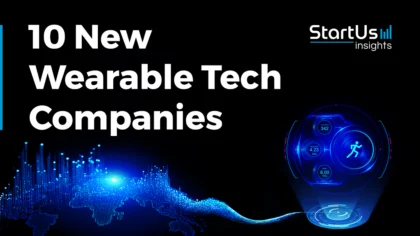Staying ahead of the technology curve means strengthening your competitive advantage. That is why we give you data-driven innovation insights into the display industry. This time, you get to discover five hand-picked light-field display startups.
Out of 70, the Global Startup Heat Map highlights 5 Top Light-Field Display Startups
The insights of this data-driven analysis are derived from the Big Data and Artificial Intelligence (AI)-powered StartUs Insights Discovery Platform, covering 2 093 000+ startups and scaleups globally. The platform gives you an exhaustive overview of emerging technologies and relevant startups within a specific field in just a few clicks.
The Global Startup Heat Map below reveals the distribution of the 70 exemplary startups and scaleups we analyzed for this research. Further, it highlights five light-field display startups that we hand-picked based on criteria such as founding year, location, funding raised, and more. You get to explore the solutions of these five startups and scaleups in this report. For insights on the other 65 light field display solutions, get in touch.
CREAL develops a Near-Eye Light Field Display
Light-field displays produce a three-dimensional (3D) image and find applications in immersive technologies like augmented reality (AR) and virtual reality (VR). They synthesize sharp images of virtual objects within the viewer’s natural range of sight. For this reason, startups offer solutions that integrate light-field technology in head-mounted displays (HMDs).
CREAL is a Swiss startup that develops a near-eye display. The light-field solution features continuous depth resolution, high spatial resolution, and a moving field-of-view (FOV). The startup enables the development of VR and mixed reality (XR) glasses that offer a natural focus without causing eye strain.
AYE3D enables Glass-free 3D
Advancements in optical fabrication and computational models of human perception enable new immersive display technologies. Startups working on light-field technology develop displays that project 3D images that are viewable without special glasses. These solutions provide a more robust 3D experience and also ensure a minimal or zero loss of brightness.
Canadian startup AYE3D offers a glass-free 3D display, FRƐ3DOM. The startup’s product provides 3D depth from 40 cm in front of the screen to infinity behind. FRƐ3DOM also features quad-high-definition (QHD) resolution, a glossy screen, and a pixel density of 120 dots per inch (dpi). The solution finds applications in industrial design, engineering, medical analysis, and entertainment.
MOPIC offers Light-Field Signage
A major benefit of glass-free products is the use of 3D in more commonplace applications such as public space advertising. For instance, 3D signage provides a richer experience and potentially generates more interest in products or services than 2D images. Startups and scaleups provide solutions that lower the cost of light-field displays to promote the adoption of 3D content.
MOPIC is a South Korean startup that develops solutions for light-field signage. The startup’s glass-free 3D signage, MOPIC Digital Signage, is viewable under different angles. MOPIC also builds a glass-free 3D monitor for a near-reality visual experience and a 3D image-making tool for content creators.
NanoAR pr0vides Realistic Holograms
Holograms provide accurate 3D images that improve visualization, interaction, and collaboration for solutions in defense, medicine, and information visualization. Light field displays reduce the cost of holography, enabling more startups and scaleups to build better holographic displays. These solutions enable a wide field of view, providing spatial, angular, and directional resolution for creating realistic holograms.
Chinese startup NanoAR makes realistic holograms. The startup’s patented transparent projection display technology turns any transparent glass or plastic media into an immersive display. The solution enables next-generation light-field displays for use in commercial buildings and automotive glasses, among other applications.
Wintual manufactures Interactive Screens
Interactive MR is on the rise as a form of storytelling in media, entertainment, education, and training. Startups develop solutions that make light-field displays interactive. The ability to interact with projected images, such as a hologram or images on a virtual screen, enables control and manipulation of content for use in mixed reality applications.
Wintual is a French startup that manufactures interactive screens. The startup offers a virtual window that provides an ultra-high-definition (UHD), photorealistic view of the outside world for windowless spaces. The view adjusts according to the viewer’s position, mimicking the field of view of an actual window. Wintual’s interactive solution finds applications in retail, museums, and trade fairs, among others.
Discover more Display Startups
Startups such as the examples highlighted in this report focus on immersive technologies, holograms, and interactive displays. While all of these technologies play a major role in advancing the industry, they only represent the tip of the iceberg. To explore display technologies in more detail, let us look into your areas of interest. For a more general overview, download one of our free Industry Innovation Reports to save your time and improve strategic decision-making.









